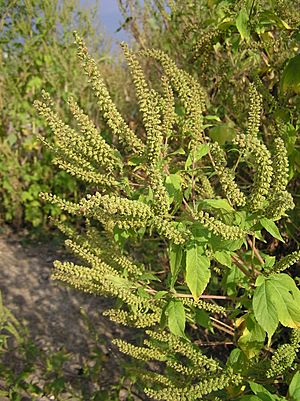Giant ragweed facts for kids
Quick facts for kids Giant ragweed |
|
|---|---|
 |
|
| Conservation status | |
| Scientific classification | |
| Genus: |
Ambrosia
|
| Species: |
trifida
|
| Synonyms | |
|
|
Ambrosia trifida, also known as giant ragweed, is a type of flowering plant in the sunflower family. It originally comes from North America. You can find it all over Canada, the United States, and northern Mexico.
Giant ragweed is also known by many other names, like great ragweed, tall ragweed, blood ragweed, and kinghead.
Contents
Where Giant Ragweed Grows
Giant ragweed is native to North America. But it has also spread to Europe and Asia. In these places, it is called an introduced species. This means it was brought there by people, not by nature. It often grows as a common weed in many areas.
What Giant Ragweed Looks Like
Giant ragweed is an annual plant. This means it grows from a seed, flowers, produces seeds, and then dies all in one year. It usually grows about 2 m (6 ft 7 in) (about 6.5 feet) tall. But in really good soil that is wet and rich, it can grow super tall, sometimes over 6 m (20 ft) (over 19 feet)!
The stems of the plant are strong and have a woody base. They can have many branches or none at all. Most of the leaves grow opposite each other on the stem. The leaves can look very different. Some are shaped like a hand with five parts, and they often have jagged edges. The biggest leaves can be over 25 cm (9.8 in) (about 10 inches) long and 20 cm (7.9 in) (about 8 inches) wide. They grow on stalks that are several centimeters long. The leaves feel rough and have tiny glands on them.
This plant has both male and female flowers on the same plant. The female flowers grow in a cluster at the bottom of a spike. The male flowers grow at the very top of the spike. After the flowers, the plant produces a fruit called a bur. This bur is only a few millimeters long and has several tiny spines on it.
Why Giant Ragweed is a Problem
Giant ragweed is known as a noxious weed. This means it's a harmful plant. It causes problems both where it naturally grows and in new places where it has been introduced. In some areas, it has become an invasive species. This means it spreads quickly and takes over.
It grows well in places where the ground has been disturbed. This includes roadsides and farm fields. Its spiny burs are very good at spreading seeds. They can stick to people, animals, and farm machines. They can also float away in water. This helps the seeds travel to new places.
Giant ragweed is bad for other plants, including crops. It grows very tall and fast. This means it can easily outcompete other plants for sunlight. It blocks the sun, so other plants can't grow well.
Farmers have also found that some giant ragweed plants are resistant to certain herbicides. Herbicides are chemicals used to kill weeds. This makes it harder to control the plant in farm fields. Scientists are working to find new ways to manage these tough weeds.
Giant Ragweed and Allergies
Giant ragweed is also a big problem because its pollen causes many people to have allergy symptoms. It is one of the most common ragweeds that causes allergies. When this plant spreads into new areas, people living there often start to experience allergic reactions. These can include sneezing, runny nose, and itchy eyes.
How People Have Used Giant Ragweed
Even though it can be a problem, giant ragweed has also been useful. Native Americans used this plant as traditional medicine. For example, the Cherokee people used it to help with insect stings, hives, fever, and pneumonia. The Iroquois people used it to treat diarrhea.
Giant ragweed has also been used in gardening. It can help speed up the process of making compost. It has also been used as a material in sheet mulch gardens.
Gallery







